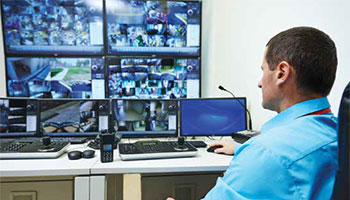
Making the Case
Providing confirmation of an actual intrusion
- By Jeremy Bates
- Jul 01, 2014
 In December 2013, the city of Akron, Ohio
made the decision to implement new protocols
that emphasized the adoption of verified
alarms in regard to dispatching police to
the properties of possible intrusions. Akron police
officials indicated that the change in policy was in
direct correlation with the estimated 10,000 alarm
calls they had received in the previous year and the
tens of thousands of alarm calls they received in
the years prior.
In December 2013, the city of Akron, Ohio
made the decision to implement new protocols
that emphasized the adoption of verified
alarms in regard to dispatching police to
the properties of possible intrusions. Akron police
officials indicated that the change in policy was in
direct correlation with the estimated 10,000 alarm
calls they had received in the previous year and the
tens of thousands of alarm calls they received in
the years prior.
Cities like Detroit, Salt Lake City and Las Vegas
have similarly taken notice of the advantages
of verified alarms, which use live audio and/or
video monitored by a trained operator. This new
era ushered in by alarm verification is able to not
only provide confirmation that an actual intrusion
is taking place within a given property, but it is also
able to provide a level of detail regarding the circumstances
of an intrusion that police dispatchers
can qualify as actionable intelligence.
Today, technology facilitates change in real
time. We live in the information age—an age of
verified social media accounts—so that we can
confirm the identity of a real person and use a
verified payment system to confirm that we’re conducting
business with a real merchant. So, what’s
wrong with a verified approach to security?
A Case for Verified Alarms
Now, to clarify, I am not advocating policies
for police to dispatch only to calls from verified
alarms, as they have done in Akron. But why not
embrace technology that allows the security industry
to do a better job at significantly reducing
false alarms, and more importantly, helping
law enforcement to catch more bad guys? As the
owner of a security company that provides both
traditional and verified alarms, I can attest that
while traditional alarms are still an effective way
of deterring potential intruders the benefits of
verified alarms are undeniable.
When Akron Police responded, two officers
at a time, to thousands of alarm calls—almost 28
per day—they recognized not only the benefit,
but often the necessity, given the inherent danger
associated with their job, of having detailed information
about what’s on the other end of those
calls. The technology and infrastructure of verified
alarms exists to be able to provide a greater,
more accurate flow of information. This enables
police officers to strategize a safer and more
tactical approach to protecting a property and
apprehending intruders when dispatched.
The Truth behind False Alarms
Beyond the added intelligence that verified alarms
afford police officers when strategizing safer and
more effective responses to real intrusion events,
verification is also able to deliver practicality of
another kind altogether: the minimization of false
alarm dispatches.
When Akron police officials presented statistics
that furthered their reason for prioritizing
responses to verified alarm calls, it was explained
that of the roughly 10,000 alarm calls received in
the previous year, 9,850 of them turned out to be
false. City officials estimated that Akron’s 98.5 percent
false alarm rate costs taxpayers $200,000 annually.
And Akron is not alone.
When last publicly addressed by the Department
of Justice (DOJ), the status of the false alarm
issue in the United States could only be described
as shocking. In 2007, the DOJ’s Office of Community
Oriented Policing Services (COPS) published
a thorough report on the issue in a problem-specific
guide for police, False Burglar Alarms. This
report found that throughout the country, local
law enforcement agencies dispatch officers to at
least 36 million alarms annually, between 94 and
98 percent of which are false. The DOJ concluded
that each year this costs taxpayers over $1.7 billion
and that the typical security alarm’s reliability is
generally between only two and six percent.
Today, with the technology and infrastructure
of verified alarms, police officers can confirm that
they’re responding to a real emergency and accordingly
prioritize their responses. One effective
false alarm reduction tool, Enhanced Call Verification
(ECV), also known as two-call verification,
is often misunderstood as a method of true alarm
verification. Without using advanced technology
like live audio or video, ECV cannot confirm an
in-progress intrusion and will not drive a priority
alarm response from law enforcement.
Results of “Crying Wolf”
When such a high percentage of all alarm calls turn
out to be harmless, it’s hardly reasonable to expect
a response to be treated with the same level of urgency
afforded to a detailed description of a breakin
provided via a verified alarm.
Here’s an analogy: Think about how you would
respond to hearing a car alarm. Probably, like me,
you would do nothing. But, if you saw somebody breaking into a car, you would surely
take the action of calling the police.
Unfortunately, false alarms inherently
lower the level of urgency
and caution in which all alarms are
responded to, detracting from the
two percent of the time that an alarm
is genuine. When law enforcement
receives a call from an alarm that
uses verified, real-time information
regarding a very real situation, they
know what they are walking into.
Standards for Priority
Response Alarms
Contrary to a common misconception,
advocates of priority response
for verified alarms in municipalities
across the country, such as the DOJ,
are not saying that they will no longer
be responding to burglar alarms.
Through the implementation of alarm
verification standards, what is in fact
being expressed is the belief that today
there exists the capabilities, products
and services to deliver greater
results. With the advent of verified
alarms, there now exists the expectation
and realization that the industry
can improve that success rate.
So, what exactly are the standards
for security alarms being given priority
response? It’s right there in the
name: verified intrusion alarms.
There are some general criteria for
what actually qualifies as a “verified
alarm.” The general theme is that a
live human—not a motion sensor or
door contact only—is involved in the
dispatch process in one way or another.
Verified alarms provide confirmation
of an actual in-progress intrusion
to a police dispatcher, while operators
at verified monitoring stations are
trained to quickly assess live audio
and/or video to confirm the reality of
an in-progress intrusion.
Confirmation of an in-progress
intrusion is an extremely high police
dispatch priority, eliciting an immediate
response, which far more frequently
results in an apprehension.
Alarm verification by an operator
is essentially the same process as
when someone reports an in-progress
intrusion with an eye-witness
account. This method of verifying
an emergency situation is associated
with the same priority as panic buttons
and hold-up alarms, eliciting
immediate police dispatch.
In 2014, an era of rapid progression
and advancement of technology
throughout industries of all kinds, priorities
should be placed on technology
that can better ensure and promote the
safety of the public and law enforcement
dedicated to their protection. It’s
only fitting that with new technology,
now is the time to embrace verified
alarms and priority alarm dispatch.
To do this is to embrace technology
and practices that are safer for police,
customers and the public, allowing
security companies to do a better job
lowering the false alarm rate, and ultimately,
promoting the alarm system’s
primary function—the apprehension
of criminals.
This article originally appeared in the July 2014 issue of Security Today.